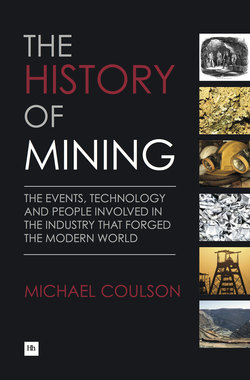Читать книгу The History of Mining - Michael Coulson - Страница 21
На сайте Литреса книга снята с продажи.
Pliny the Elder (23-79 AD)
ОглавлениеAlthough the great Roman soldier and observer Pliny the Elder was not a mining man, his writings on mining operations that he visited across the Roman Empire, particularly Spain where he was a procurator responsible for mine administration, have created an invaluable record for posterity. The book in which they appear, Historia Naturalis, is in fact a comprehensive study of geography and nature in the Roman Empire, and the sections on metals and mining are just a small part of the work. However, they are one of the few sources of directly observed comments on mining techniques in the ancient world that have survived to this day.
Born Gaius Plinius Secundus in 23 AD in Como, northern Italy, Pliny’s family held equestrian status indicating that they had money and were deemed aristocrats or knights. Pliny received formal education in Rome where his tutor, Pomponius, who was one of Rome’s leading poets, provided Pliny with connections important to his future career. At the age of 21 he went to the Low Countries to serve as a military tribune, an administrative post, but soon became a military officer. For the next few years Pliny served in the Lower Rhine area where he saw active service under his old tutor Pomponius.
At this stage, around 50 AD, Pliny began to write books, which included a biography of Pomponius and a history of the Germanic Wars. He returned to Rome where he might have been expected to continue his career in public service. It was, however, the age of Nero and Pliny’s position as a serious historian did not fit into Nero’s increasingly debauched society. He wrote further books which did not attract positive comment and as Nero’s rule ended with the Emperor’s suicide, a vicious civil war broke out. Around that time Pliny’s brother-in-law died and Pliny took on the guardianship of his nephew Pliny the Younger.
Vespasian, whose son Titus was a great friend of Pliny’s, had taken up arms to press his claim to become emperor as the post-Nero situation became increasingly chaotic. Vespasian entered Rome as emperor in 69 AD and from that point on Pliny’s career took a major turn for the better as he assumed a number of important public posts as a procurator, which took him all over the Empire. One of the regions he visited was Spain, where his responsibilities included keeping an eye on the gold mines which had assumed a key role in the Empire’s finances. It was here that he made copious notes on the techniques of mining and treating gold at locations such as Las Medulas in Leon, observations which eventually were incorporated into the mining section of his Historia Naturalis. He was not remotely a gold bull, however, as he believed that it merely played on man’s natural greed. He also made observations about silver mining, base metal (including lead) mining and even diamonds. The Historia also contained sections covering the use of metals in what we would now call manufacturing.
Pliny’s career continued with his appointment as prefect for the Roman navy in the western Mediterranean and it was during this phase of his life that Historia Naturalis was completed and published in 77 AD. In August 79 AD Pliny was holidaying with his sister and Pliny the Younger in Misenum when Mount Vesuvius erupted. Pliny ordered a fleet of ships, which he commanded, to set sail to rescue those who had escaped the disaster and were gathered on the shore outside Pompeii. He, unfortunately, had to spend the night ashore and in the morning was found dead overcome by the sulphurous fumes from Vesuvius.
The only book of Pliny’s to have survived is Historia Naturalis. Whilst archaeologists have done much work on ancient mining sites around the world and in so doing have provided much useful information on mining construction and techniques, Pliny’s observations are the real thing. They reveal the relatively sophisticated mining methods of the Romans, including the use of hydraulic (water pressure) style mining 1700 years before it was introduced into 19th century mining. As such Pliny’s work holds an invaluable place in the study of the mining industry’s historic development.
